AS SEEN IN





Home » Why I am saving tree sparrows
I moved to Fotherdale Farm, high on the Yorkshire Wolds, in 1998 and when I got here I was disappointed by the lack of wildlife in my garden. But then again it was hardly a garden, more an expanse of mud that had been levelled by a JCB digger, following the renovations of the farmhouse. There were barely any plants here to provide food or cover for birds.
Next door were farm buildings where single pairs of pied wagtails, wrens and swallows had settled. But my house had just one pair of tree sparrows and a few house martins in the eaves. It wasn’t a great start but I was particularly pleased by the presence of the tree sparrows, since they are an endangered species.
Tree sparrows are sociable, noisy birds. But in recent years Britain’s hedgerows, which were once alive with their cheerful chatter, have fallen silent. Populations of tree sparrows declined by 95 per cent in the UK between 1970 and 2008 and numbers are still so critically low that these birds feature on the RSPB red list of species in need of urgent conservation action.
I wanted to do my bit, so I promptly put up a bird feeder. The birds were cautious at first, but in time the two tree sparrows became regular visitors. I had read that they loved sunflower hearts but I found that they seemed to be spilling a lot of the hearts onto the floor so instead I put out a mixture of seeds. I was delighted when the pair brought their first brood to the table. I watched intrigued as they showed their young how to perch on the feeders.
Tree sparrows belong to an order of birds known as passerines, derived from the Latin ‘passer’ which actually means ‘sparrow’. Passerines include more than half of all bird species and are distinguished by the way in which their toes can move independently of one another. This makes them excellent at perching.
The youngsters quickly cottoned on and before long the parent birds produced a second brood and, later that summer, even a third! By autumn, I had a flock of 16 chattering tree sparrows outside my kitchen window.
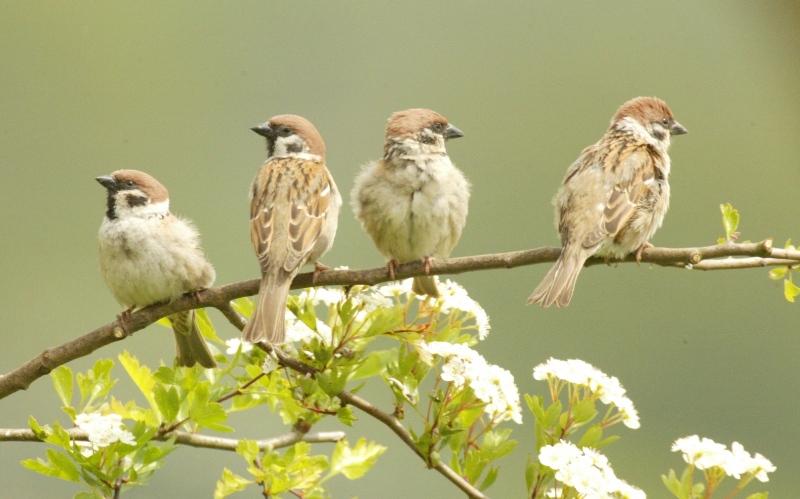
My efforts were costing me a fortune in bird food, but the rewards were worth it. These little birds are real characters. It’s wonderful to hear a hedge full of their chatter. They are noisy little things! Often the clamour outside my studio is deafening. It lasts throughout the breeding season and well into autumn. Once a visitor to my gallery asked me what was causing the racket outside. I was quite proud to reply that it was in fact tree sparrows and to show him just how many of these rare birds I had feeding outside.
I put up a few nest boxes for this burgeoning population and the following spring was overjoyed to see them occupied. I continued to add new boxes every year. The more boxes I put up the more tree sparrows I got. It was such a simple conservation measure yet so successful. Tree sparrows like to nest in colonies so I built nest box terraces for them. These consisted of a single box divided into three separate nest chambers. I even built a massive one with eight chambers; it was a bit like a block of flats.
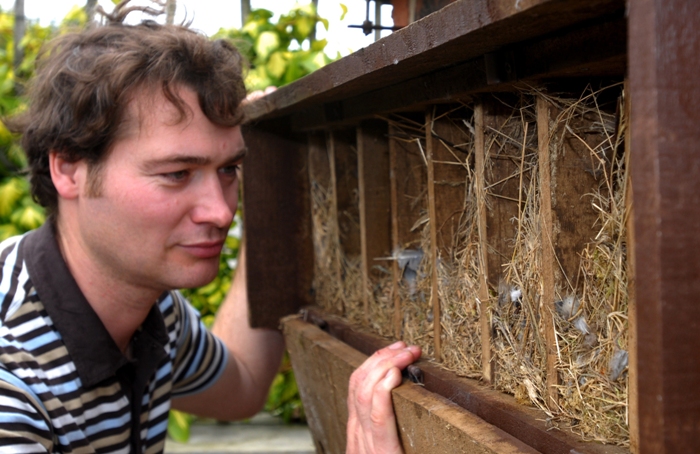
It was quite funny when the first bird to move in to this one was actually a great tit! It had chosen one of the middle apartments and was horrified when a pair of noisy tree sparrows moved in next door. The feisty great tit would peck at any neighbour that dared to pop its head through its entrance hole.
In hindsight, the block of eight was too large. The tree sparrows were confused over which nest was which and squabbles broke out when a bird entered the wrong nest. Sometimes the fights were serious and two birds would be locked in combat as they tumbled down to the ground.
At the same time I tried to encourage more house martins to nest here. I put up specially designed nest boxes for them in advance of their annual return from Africa, to save them from having to build their own from scratch. Yet the tree sparrows were quick to colonise these too.
When the house martins reached Fotherdale Farm, exhausted by their 4,000 mile journey, they were predictably keen to investigate the new nesting sites. But when they hovered in front of the entrance holes they were greeted by angry tree sparrows. The poor house martins were left to build their own mud nests as usual. It was a dry spring and so to ease their burden I left out trays of wet mud for them.
One spring, a pair of mistle thrushes nested in a clump of ivy on a gate post on my driveway. I watched as they set about making their nest together, proudly flying to and fro in unison with bits of moss and long grasses in their beaks. Then I noticed that as fast as they were bringing in their nesting materials, the tree sparrows were taking them away!
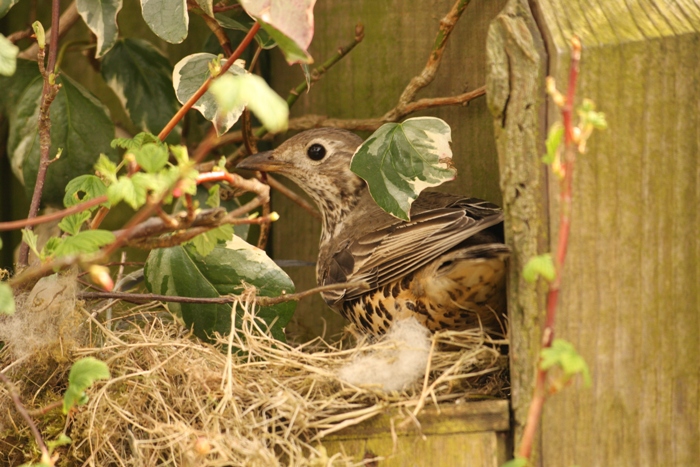
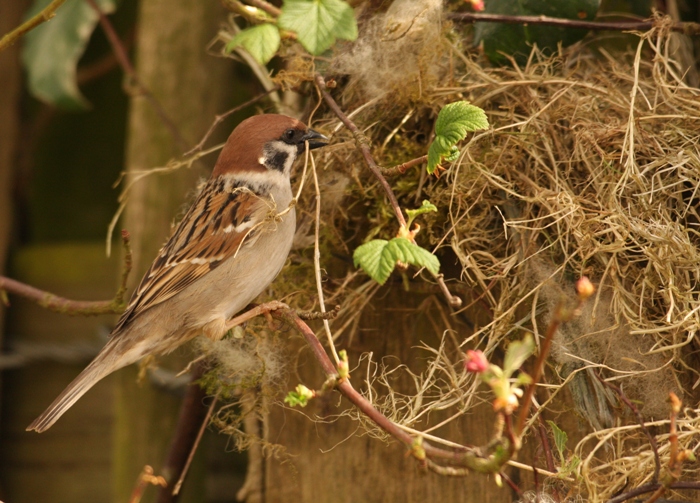
The thieving tree sparrows would wait for each delivery and, as soon as the thrushes flew off to gather more, would raid it. The sparrows had discovered an easy way to line their own nest. On their return, the thrushes looked down in dismay before looking quizzically at each other. They seemed utterly confused as to why they were making so little progress in spite of their hard work. It was so comical.
Inevitably, the mistle thrushes returned just in time to catch a tree sparrow red-handed. They chased the bandit off but not before the tree sparrow, showing true fighting spirit, had grabbed a piece of long grass in its beak as it fled. After that the mistle thrushes kept a constant vigil. One would stand guard whilst the other brought back the necessary materials to complete the nest.
While the tree sparrows in my garden are now, dare I say it, common, over the last 20 years I have only ever seen about half a dozen of their cousins – the house sparrow – here. Sparrows are sparrows to the untrained eye, but there are striking differences between them. Male house sparrows are heavily marked with chestnut wings and white wing bars, a black bib and a grey cap, while females are a dull buff brown.
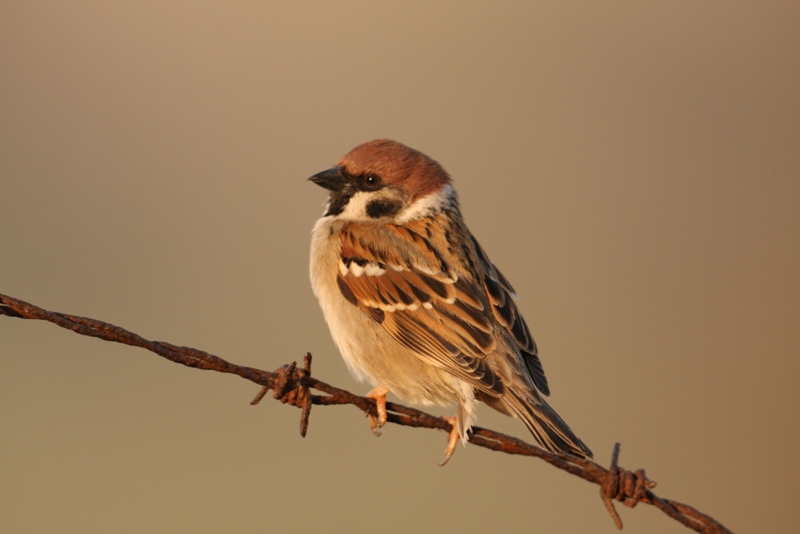
By contrast, male and female tree sparrows look alike. Both sport smart ginger caps on their heads and a black spot on each cheek. Both species are in serious decline, although at populations of 200,000 pairs, tree sparrows are more endangered. They are also hardier and tend to live in rural areas.
The good news is that in my corner of Yorkshire tree sparrows are holding their own. I now have 35 pairs nesting here every year and by the end of each breeding season I can see flocks in their hundreds in my garden. I often get keen bird watchers visiting my gallery and they double take at seeing such an endangered bird in such large numbers around my feeders. And, from here they have spread, colonising the local area too.
This year was the first time I have celebrated this success story in paint. My latest painting features 19 newly fledged tree sparrows, all huddled along a hawthorn branch. I painted it from a photograph taken of the sparrows packed so tightly along the branch I thought it might break! And the composition took even longer because the branch is one that I deliberately left to grow out from my hedge after I noticed that the tree sparrows used to use the hedge for cover. I named the final painting, When the Bough Breaks.
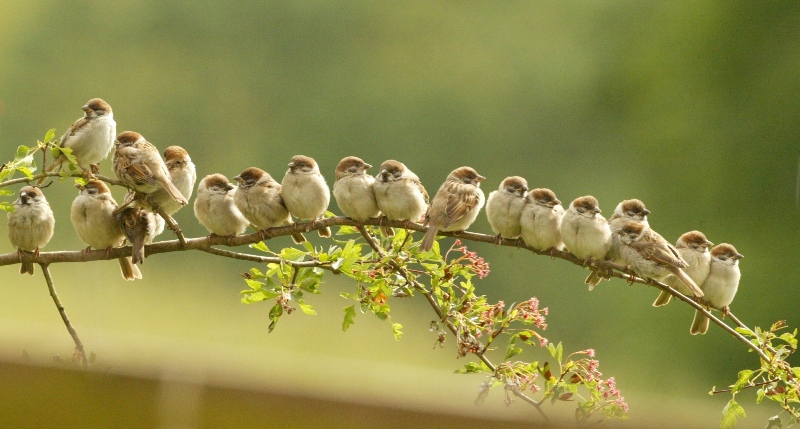
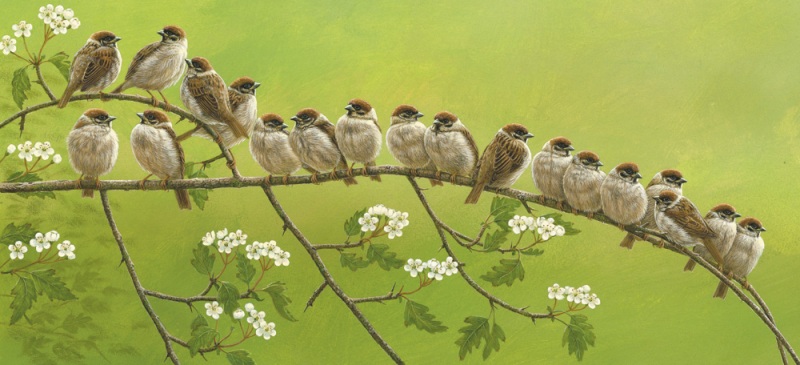
Of course, painting 38 eyes and 114 toes took some patience – but not as long as this 20 year conservation project!.
Sign up to my newsletter for updates on news, wildlife sightings, products and more directly to your inbox
AS SEEN IN





THE ROBERT FULLER GALLERY
FOTHERDALE FARM
THIXENDALE, MALTON
YO17 9LS
UNITED KINGDOM
TEL: +44 (0) 1759 368355
EMAIL: mail@robertefuller.com
3 Responses
It’s great that you have done so much to help these lovely birds. In the road where I live, there’s house sparrows at the other end of the road but they don’t come into my garden despite having 14 feeders and 2 bird tables. I can’t think how I can tempt them up this way although I have a whole variety of birds regularly visiting
For the first time ever there is a tree sparrow in my garden eating seed here in the hills of peak forest in Derbyshire. I will do my best to encourage it!
My Tree Sparrows are booming here at Eskmeals Robert and to my surprise, have ousted the House Sparrows who now have to make do with a feeder at the other side of the house! I first fell in love with Tree Sparrows when I used to see them ‘en-masse’ at Leighton Moss Nature Reserve, feeding on the ground where the local gamekeeper of the time, fed his Pheasants. When I finally succeeded in getting some nesting Tree Sparrows I was ecstatic, but to my surprise they are reluctant to feed on the ground, leaving that to the Chaffinches, Blackbirds and Robins – the latter two spending more time chasing each other off, than feeding! My latest feeder ‘visitor’ this morning was a Buzzard which was obviously desperate for food (the Field Voles are non-existent this year) and crashed into the birds feeding on the ground! Made an unusual change from the pesky female Sparrowhawk I get all too often! Have a good Christmas and massive Christmas card sales!!!